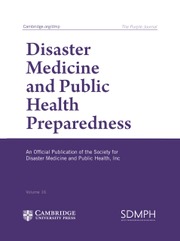Dear Editor,
We would like to give ideas on the publication “Rising Cases of Dengue and Malaria in Flood Affected Areas.”Reference Vohra, Aqib, Jamal, Mehmood and Yasin1 Floods, according to Vohra et al., can have a significant impact on the reproduction, growth, behavior patterns, and population dynamics of arthropod vectors such as mosquitos and ticks that act as carriers for dengue, plasmodium, and nonhuman vertebrate reservoirs, either independently or collectively.Reference Vohra, Aqib, Jamal, Mehmood and Yasin1 According to Vohra et al., providing Vitamin C supplements, fluids, and electrolyte balance to boost immunity is an important measure to deal with dengue, as is practicing solar disinfection, good hygiene, and getting the community involved to deal with rising cases.Reference Vohra, Aqib, Jamal, Mehmood and Yasin1
We completely agree that a natural disaster can cause the outbreak of an infectious disease. In terms of tropical mosquito-borne infection, there may or may not be an increase in incidence following flooding. There may or may not be an increase in tropical mosquito-borne infections following floods. Malaria, dengue, and flooding are all widespread in the Indochina region where we live. Regardless of the flooding, the rising rates of dengue and malaria during the rainy season are a prevalent public health concern. Indeed, a meta-analysis of the effect of flooding on the incidence of mosquito-borne infection revealed that there is still insufficient data to support the relationship, and the confounding effects of the background environment must be acknowledged.Reference Coalson, Anderson, Santos, Garcia, Romine, Dominguez, Richard, Little, Hayden and Ernst2 It is still difficult to conclude that the flooding is directly related to the rise in mosquito-borne sickness. To demonstrate that the floods have a direct correlation to the occurrence of tropical mosquito-borne infection in the context of Vohra et al., there should be long-term data on the incidence of diseases and local weather for many years.


